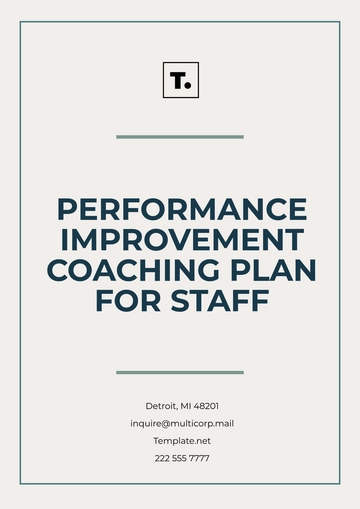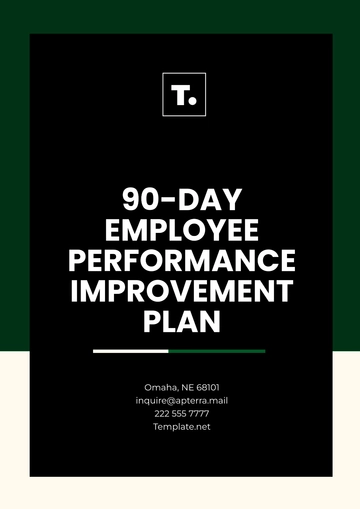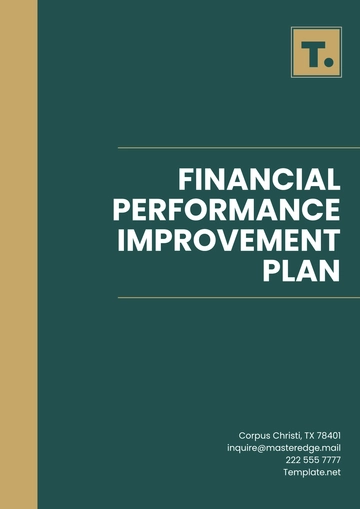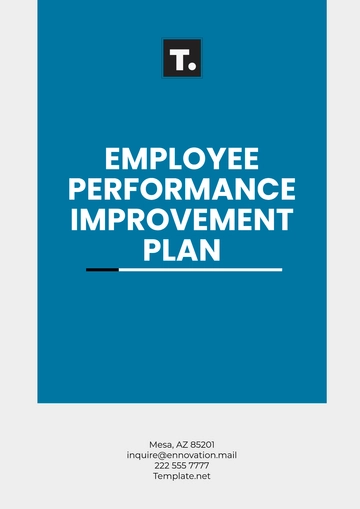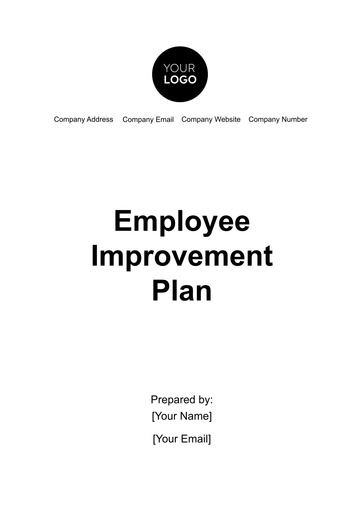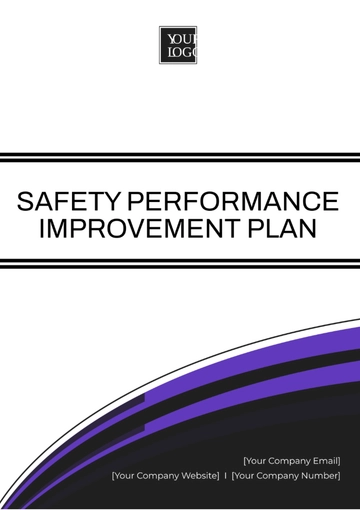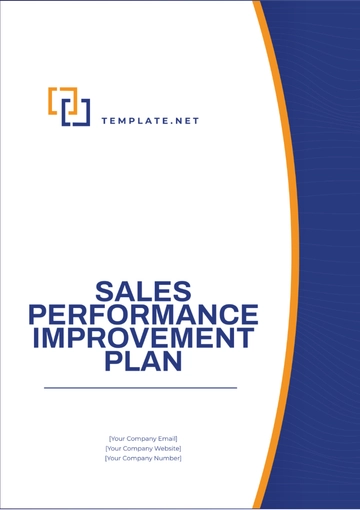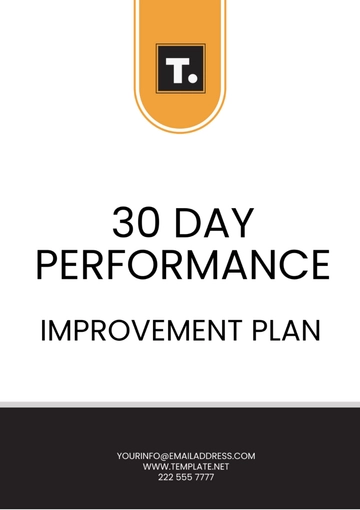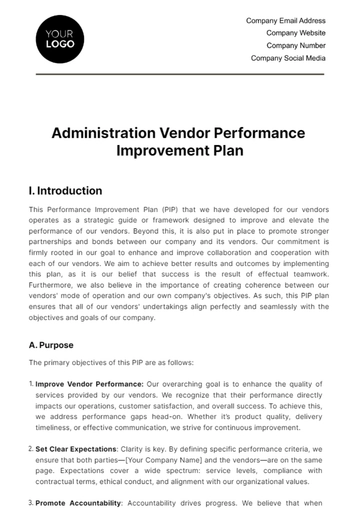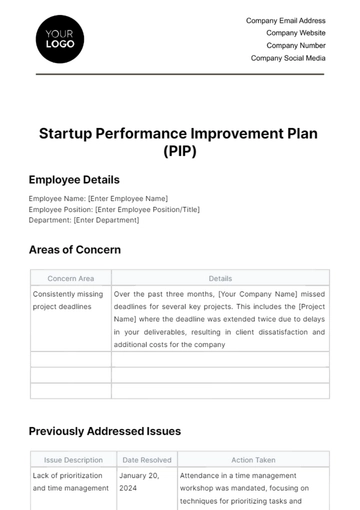Free Employee Improvement Plan
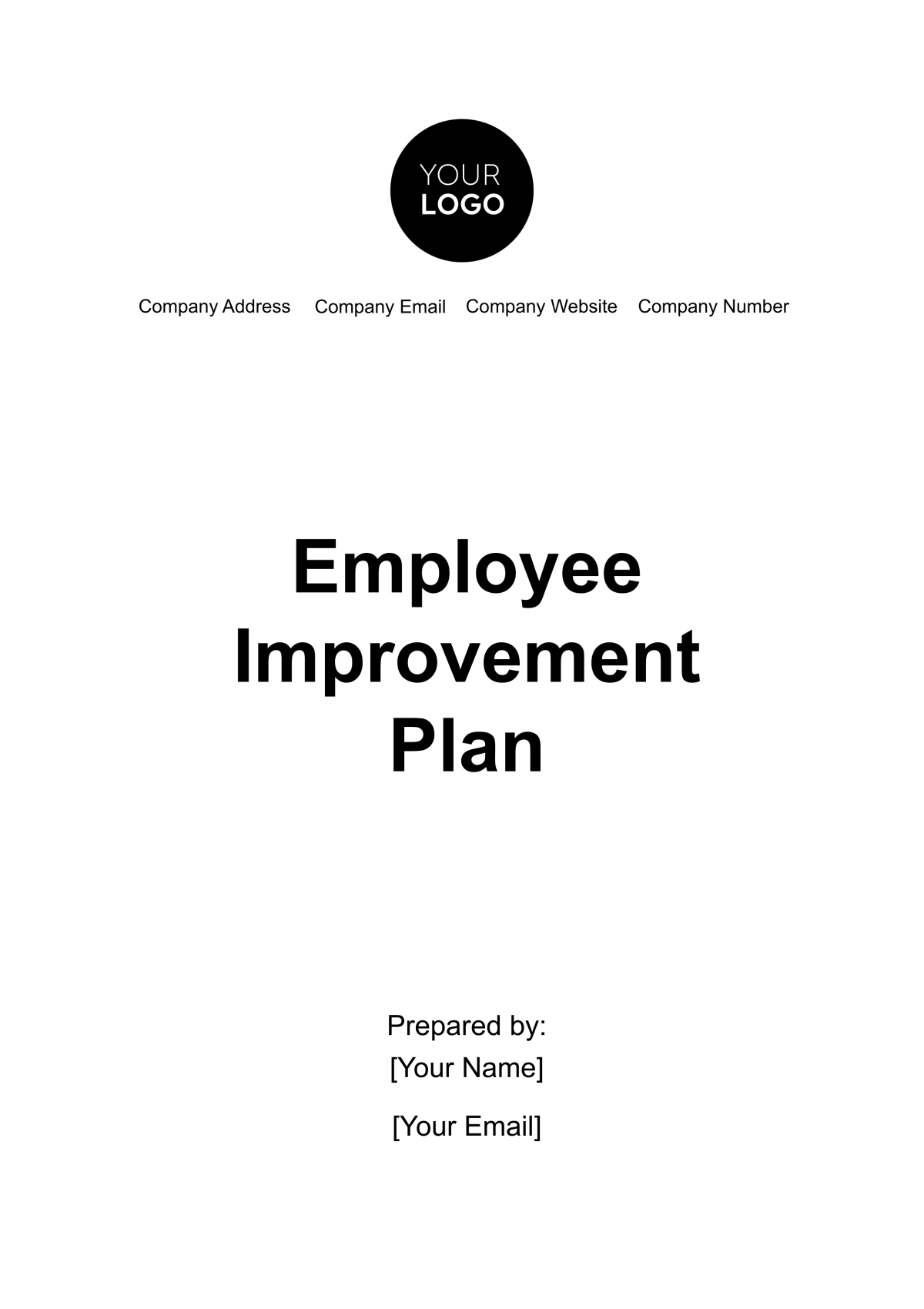
1. Introduction
The Employee Improvement Plan (EIP) is a structured approach designed to support and enhance the performance of employees at [Your Company Name]. This plan addresses performance issues by providing a clear path for development, setting measurable goals, and offering the necessary resources and support. The EIP aims to foster a culture of continuous improvement, professional growth, and organizational excellence.
1.1 Purpose
The purpose of the EIP is to:
Identify Areas for Improvement: Recognize specific areas where an employee's performance may not align with company expectations.
Develop Tailored Action Plans: Create customized strategies to address performance gaps and enhance skills.
Provide Ongoing Support: Ensure employees have access to the necessary resources, training, and mentorship to facilitate improvement.
Evaluate Effectiveness: Continuously monitor progress and assess the success of the plan to make necessary adjustments.
Achieve Organizational Goals: Align individual performance with broader organizational objectives to drive overall success.
1.2 Scope
The EIP applies to all employees at [Your Company Name], including full-time, part-time, and temporary staff. It covers various performance issues, from minor discrepancies to significant gaps that affect job performance and organizational goals.
1.3 Benefits
Implementing an EIP offers several benefits:
Enhanced Employee Performance: Through targeted development and support, employees can improve their skills and performance.
Increased Employee Engagement: Employees who receive constructive feedback and support are more likely to be engaged and motivated.
Better Organizational Alignment: Ensuring that employees’ performance aligns with organizational goals promotes overall success.
Reduced Turnover: Addressing performance issues proactively can reduce employee turnover by providing a clear path for improvement.
2. Objectives of the Employee Improvement Plan
The EIP’s objectives are designed to address various aspects of employee performance and development.
2.1 Identify Performance Gaps
Identifying performance gaps involves:
Assessing Current Performance: Comparing actual performance against expected standards to identify areas needing improvement.
Analyzing Root Causes: Determining underlying issues that may be contributing to performance deficiencies, such as lack of skills, unclear expectations, or external factors.
2.2 Develop Action Plans
Developing action plans requires:
Defining Clear Goals: Setting specific, measurable objectives for improvement based on identified performance gaps.
Creating Step-by-Step Strategies: Outlining the exact steps the employee needs to take to achieve the goals, including timelines and milestones.
2.3 Provide Support and Resources
Providing support and resources involves:
Access to Training Programs: Identifying and facilitating relevant training and development opportunities.
Offering Mentorship: Pairing the employee with a mentor or coach who can provide guidance and feedback.
2.4 Monitor and Evaluate Progress
Monitoring and evaluating progress includes:
Regular Check-Ins: Scheduling periodic meetings to review progress, discuss challenges, and adjust the plan as needed.
Performance Metrics: Using quantitative and qualitative metrics to measure progress towards goals.
2.5 Achieve Desired Outcomes
Achieving desired outcomes involves:
Meeting Performance Standards: Ensuring that the employee meets or exceeds the performance expectations set out in the plan.
Enhancing Job Satisfaction: Improving the employee’s job satisfaction and overall engagement with their role.
3. Employee Improvement Plan Process
The EIP process is a systematic approach that includes several phases, each with specific actions and objectives.
3.1 Initial Assessment
3.1.1 Performance Review
The performance review is a comprehensive evaluation that includes:
Quantitative Metrics: Metrics such as sales numbers, project completion rates, or other measurable data relevant to the employee’s role.
Qualitative Feedback: Supervisor comments on aspects such as teamwork, communication skills, and problem-solving abilities.
Self-Assessment: Encouraging the employee to reflect on their own performance, challenges, and areas for improvement.
3.1.2 Identifying Performance Issues
Identifying performance issues involves:
Job Description Comparison: Reviewing the employee’s job description and comparing it with their actual performance to identify discrepancies.
Historical Performance Data: Examining past performance reviews and feedback to identify patterns and recurring issues.
Colleague Feedback: Gathering feedback from peers and team members who interact with the employee regularly.
3.2 Developing the Improvement Plan
3.2.1 Setting SMART Goals
Setting SMART goals involves:
Specific: Clearly defining what needs to be achieved, such as improving customer satisfaction scores or increasing productivity.
Measurable: Establishing criteria to measure success, such as achieving a specific percentage increase in performance metrics.
Achievable: Ensuring that the goals are realistic given the employee’s current skills, resources, and job responsibilities.
Relevant: Aligning the goals with the employee’s role and the company’s strategic objectives to ensure relevance.
Time-bound: Setting a clear deadline for achieving the goals, such as three months or six months, to create a sense of urgency and accountability.
3.2.2 Action Plan
The action plan details the steps required to achieve the goals:
Training and Development: Identifying specific courses, workshops, or certifications that will help the employee build the necessary skills.
Mentorship and Coaching: Arranging for regular meetings with a mentor or coach who can provide guidance, feedback, and support.
Resource Allocation: Ensuring the employee has access to any tools, software, or other resources needed to complete their tasks effectively.
3.2.3 Support and Resources
Providing support and resources includes:
Training Programs: Facilitating access to internal or external training programs that address the identified performance gaps.
Mentorship: Assigning a mentor with relevant experience who can offer personalized guidance and support.
Workshops and Seminars: Encouraging attendance at industry workshops and seminars to gain new insights and skills.
3.3 Implementation
3.3.1 Communicating the Plan
Effective communication of the plan involves:
Formal Meeting: Holding a meeting with the employee to discuss the EIP in detail, including goals, action steps, and expectations.
Written Documentation: Providing the employee with a written copy of the plan to review and refer to as needed.
3.3.2 Execution of Action Steps
Executing the action steps includes:
Training and Development: The employee attends required training programs and applies new skills to their work.
Regular Check-ins: The employee has scheduled meetings with their manager or mentor to discuss progress and address any issues.
3.4 Monitoring and Evaluation
3.4.1 Progress Reviews
Progress reviews involve:
Weekly or Bi-weekly Check-ins: Conducting brief meetings to monitor progress, discuss challenges, and provide feedback.
Monthly Performance Reviews: Comprehensive reviews that assess overall progress towards achieving the SMART goals and making any necessary adjustments.
3.4.2 Feedback and Adjustments
Providing feedback and making adjustments includes:
Revising Goals: Adjusting goals or timelines if needed based on the employee’s progress and any changes in their role or responsibilities.
Additional Support: Offering extra resources or support if the employee is struggling to meet the goals.
3.5 Conclusion of the Plan
3.5.1 Final Evaluation
The final evaluation assesses:
Assessment of Achievements: Reviewing the extent to which the employee has met the SMART goals and addressed performance issues.
Feedback from Stakeholders: Collecting input from supervisors, peers, and other relevant individuals to evaluate overall improvement.
3.5.2 Decision Making
Based on the final evaluation:
Successful Completion: Recognizing the employee’s achievements and concluding the plan if goals have been met.
Extended Plan: Extending the plan with revised goals and action steps if further improvement is needed.
Alternative Actions: Considering other actions, such as reassignment, additional training, or disciplinary measures if improvement is insufficient.
4. Roles and Responsibilities
4.1 Employee Responsibilities
The employee is responsible for:
Active Participation: Engaging fully in the improvement plan, including completing training, attending meetings, and implementing feedback.
Open Communication: Regularly updating their manager or mentor on progress, discussing challenges, and seeking assistance as needed.
Self-Motivation: Demonstrating a proactive attitude towards their development and striving to meet the goals set in the plan.
4.2 Manager Responsibilities
Managers are responsible for:
Providing Guidance: Offering clear instructions, support, and feedback to help the employee achieve their improvement goals.
Monitoring Progress: Regularly checking in with the employee to assess their progress and address any issues.
Offering Feedback: Providing constructive feedback and helping the employee make adjustments to their action plan as needed.
4.3 Human Resources Responsibilities
HR is responsible for:
Facilitating the Process: Assisting in the development, implementation, and monitoring of the improvement plan.
Ensuring Compliance: Ensuring that the EIP adheres to company policies, legal requirements, and ethical standards.
Providing Resources: Offering access to training programs, mentorship, and other resources needed for the employee’s development.
5. Documentation and Record Keeping
5.1 Documentation Requirements
Documentation should include:
Initial Assessment Reports: Records of the performance review, identified issues, and initial discussions.
Action Plans: Detailed descriptions of the goals, action steps, and resources required.
Progress Reports: Documentation of regular check-ins, feedback sessions, and updates on progress.
Final Evaluation: Summary of the final assessment, including achievements and decisions made.
5.2 Record Storage
Records should be stored securely:
Electronic Records: Storing digital documents in a secure, accessible location with restricted access to authorized personnel.
Physical Records: If applicable, keeping hard copies in a locked, confidential file to ensure privacy and security.
6. Legal and Ethical Considerations
6.1 Compliance with Employment Laws
The EIP must adhere to:
Anti-Discrimination Laws: Ensuring that the plan is applied equitably and does not discriminate based on race, gender, age, disability, or other protected characteristics.
Privacy Laws: Protecting the employee’s personal information and maintaining confidentiality throughout the process.
6.2 Ethical Standards
The plan should meet ethical standards:
Fairness: Ensuring fair treatment and consistency in applying the improvement plan across all employees.
Transparency: Providing clear and honest communication about expectations, goals, and evaluation criteria.
- 100% Customizable, free editor
- Access 1 Million+ Templates, photo’s & graphics
- Download or share as a template
- Click and replace photos, graphics, text, backgrounds
- Resize, crop, AI write & more
- Access advanced editor
Help employees reach their full potential with the Employee Improvement Plan Template from Template.net. This editable and customizable template outlines performance goals and strategies. Use our Ai Editor Tool to tailor the plan for individual employee needs.
You may also like
- Finance Plan
- Construction Plan
- Sales Plan
- Development Plan
- Career Plan
- Budget Plan
- HR Plan
- Education Plan
- Transition Plan
- Work Plan
- Training Plan
- Communication Plan
- Operation Plan
- Health And Safety Plan
- Strategy Plan
- Professional Development Plan
- Advertising Plan
- Risk Management Plan
- Restaurant Plan
- School Plan
- Nursing Home Patient Care Plan
- Nursing Care Plan
- Plan Event
- Startup Plan
- Social Media Plan
- Staffing Plan
- Annual Plan
- Content Plan
- Payment Plan
- Implementation Plan
- Hotel Plan
- Workout Plan
- Accounting Plan
- Campaign Plan
- Essay Plan
- 30 60 90 Day Plan
- Research Plan
- Recruitment Plan
- 90 Day Plan
- Quarterly Plan
- Emergency Plan
- 5 Year Plan
- Gym Plan
- Personal Plan
- IT and Software Plan
- Treatment Plan
- Real Estate Plan
- Law Firm Plan
- Healthcare Plan
- Improvement Plan
- Media Plan
- 5 Year Business Plan
- Learning Plan
- Marketing Campaign Plan
- Travel Agency Plan
- Cleaning Services Plan
- Interior Design Plan
- Performance Plan
- PR Plan
- Birth Plan
- Life Plan
- SEO Plan
- Disaster Recovery Plan
- Continuity Plan
- Launch Plan
- Legal Plan
- Behavior Plan
- Performance Improvement Plan
- Salon Plan
- Security Plan
- Security Management Plan
- Employee Development Plan
- Quality Plan
- Service Improvement Plan
- Growth Plan
- Incident Response Plan
- Basketball Plan
- Emergency Action Plan
- Product Launch Plan
- Spa Plan
- Employee Training Plan
- Data Analysis Plan
- Employee Action Plan
- Territory Plan
- Audit Plan
- Classroom Plan
- Activity Plan
- Parenting Plan
- Care Plan
- Project Execution Plan
- Exercise Plan
- Internship Plan
- Software Development Plan
- Continuous Improvement Plan
- Leave Plan
- 90 Day Sales Plan
- Advertising Agency Plan
- Employee Transition Plan
- Smart Action Plan
- Workplace Safety Plan
- Behavior Change Plan
- Contingency Plan
- Continuity of Operations Plan
- Health Plan
- Quality Control Plan
- Self Plan
- Sports Development Plan
- Change Management Plan
- Ecommerce Plan
- Personal Financial Plan
- Process Improvement Plan
- 30-60-90 Day Sales Plan
- Crisis Management Plan
- Engagement Plan
- Execution Plan
- Pandemic Plan
- Quality Assurance Plan
- Service Continuity Plan
- Agile Project Plan
- Fundraising Plan
- Job Transition Plan
- Asset Maintenance Plan
- Maintenance Plan
- Software Test Plan
- Staff Training and Development Plan
- 3 Year Plan
- Brand Activation Plan
- Release Plan
- Resource Plan
- Risk Mitigation Plan
- Teacher Plan
- 30 60 90 Day Plan for New Manager
- Food Safety Plan
- Food Truck Plan
- Hiring Plan
- Quality Management Plan
- Wellness Plan
- Behavior Intervention Plan
- Bonus Plan
- Investment Plan
- Maternity Leave Plan
- Pandemic Response Plan
- Succession Planning
- Coaching Plan
- Configuration Management Plan
- Remote Work Plan
- Self Care Plan
- Teaching Plan
- 100-Day Plan
- HACCP Plan
- Student Plan
- Sustainability Plan
- 30 60 90 Day Plan for Interview
- Access Plan
- Site Specific Safety Plan
